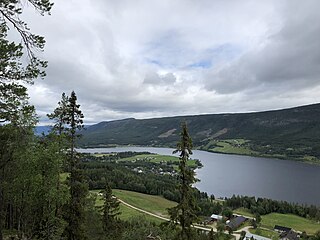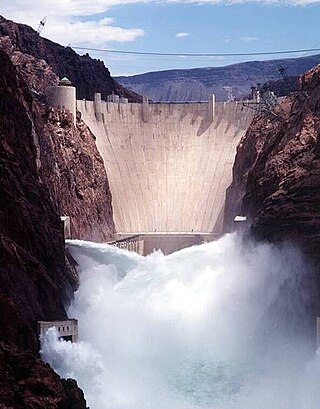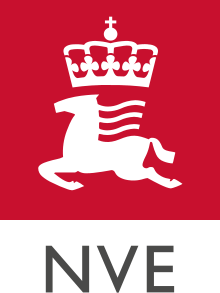Environment and Climate Change Canada is the department of the Government of Canada responsible for coordinating environmental policies and programs, as well as preserving and enhancing the natural environment and renewable resources. It is also colloquially known by its former name, Environment Canada.

The electricity sector in Norway relies predominantly on hydroelectricity. A significant share of the total electrical production is consumed by national industry.

The Scottish Environment Protection Agency is Scotland's environmental regulator and national flood forecasting, flood warning and strategic flood risk management authority. Its main role is to protect and improve Scotland's environment. SEPA does this by helping business and industry to understand their environmental responsibilities, enabling customers to comply with legislation and good practice and to realise the economic benefits of good environmental practice. One of the ways SEPA does this is through the NetRegs environmental guidance service. It protects communities by regulating activities that can cause harmful pollution and by monitoring the quality of Scotland's air, land and water. The regulations it implements also cover the storage, transport and disposal of radioactive materials.
Holmvatnet is a lake and a reservoir in Rana Municipality in Nordland county, Norway. It is located northeast of the villages of Mæla and Myklebustad.

Avalsjøen is a lake in the municipality of Lunner in Akershus county, Norway.

Statkraft AS is a hydropower company, fully owned by the Norwegian state. The Statkraft Group is Europe's largest generator of renewable energy, as well as Norway’s largest and the Nordic region's third largest energy producer. Statkraft develops and generates hydropower, wind power, gas power, district heating and solar power. It is also a player in the international energy markets. The company has 5,300 employees in 21 countries with their headquarters located in Oslo, Norway.

Toke is a lake in Telemark county, Norway. The lake is located primarily in Drangedal Municipality, but it also extends slightly into Kragerø Municipality and Bamble Municipality. The lake consists of several areas: Upper Toke and Lower Toke, which is connected via Straumen, literally 'the stream'. At the north end of Upper Toke is the village of Prestestranda. In the south, the eastern arm of Lower Toke (Rørholtfjorden) reaches into Bamble municipality and the southern part reaches into Kragerø, where its outlet is the river Lundereidelva where the Dalfoss hydroelectric plant is located. The lake, with its inflow, constitutes the majority of the Kragerø watershed.

Lomnessjøen is a lake in Rendalen Municipality in Innlandet county, Norway. The villages Åkre and Otnes are located on the shores of the lake. The lake is part of the Renaelva river system. The Renaelva river flows into the lake from the north. The south end of the river drains into the larger lake Storsjøen which is about 3 kilometres (1.9 mi) to the south of this lake.
Falningsjøen is a lake in Tynset Municipality in Innlandet county, Norway. The lake lies about 4.5 kilometres (2.8 mi) northeast of the village of Yset. The Ya River begins at this lake. The Forollhogna National Park boundary lies at the north end of the lake.
Innerdalsvatnet is a lake in Tynset Municipality in Innlandet county, Norway. It is a significant part of the Orkla watershed. The 5.88-square-kilometre (2.27 sq mi) lake lies about 10 kilometres (6.2 mi) west of the village of Yset. The northwest end of the lake has a large dam on it to control the level of the water for hydropower. The dam is actually located on the municipal and county border. The lake holds about 150,000,000 cubic metres (4.0×1010 US gal) of water which is run through a long tunnel to two nearby power stations.
Siksjøen is a lake in the municipality of Os in Innlandet county, Norway. The 2.69-square-kilometre (1.04 sq mi) lake is located in the Tufsingdalen valley in the southeastern part of the municipality, about 25 kilometres (16 mi) southeast of the village of Os.

Central Norway is an informal, unclearly defined region of Norway. In its most limited usage, the term "Central Norway" may refer only to Trøndelag county; however, it may also be understood to include all or parts of the county of Møre og Romsdal, some parts of Nordland county, as well as some municipalities in the northern part of Innlandet county.

The Norwegian Offshore Directorate is a Norwegian government agency responsible for the regulation of the petroleum resources on the Norwegian continental shelf. Based in Stavanger, its mission is to ensure that the petroleum resources are allocated in an optimal way, at the same time incurring minimal environmental impact. It is subordinate to the Norwegian Ministry of Petroleum and Energy.

Energy laws govern the use and taxation of energy, both renewable and non-renewable. These laws are the primary authorities related to energy. In contrast, energy policy refers to the policy and politics of energy.

Norway is a heavy producer of renewable energy because of hydropower. Over 99% of the electricity production in mainland Norway is from 31 GW hydropower plants. The average hydropower is 133 TWh/year. There is also a large potential in wind power, offshore wind power and wave power, as well as production of bio-energy from wood. Norway has limited resources in solar energy, but is one of the world's largest producers of solar grade silicon and silicon solar cells.
Agnar Aas is a Norwegian civil servant.

Hydropower policy in the United States includes all the laws, rules, regulations, programs and agencies that govern the national hydroelectric industry. Federal policy concerning waterpower developed over considerable time before the advent of electricity, and at times, has changed considerably, as water uses, available scientific technologies and considerations developed to the present day; over this period the priority of different, pre-existing and competing uses for water, flowing water and its energy, as well as for the water itself and competing available sources of energy have changed. Increased population and commercial demands spurred this developmental growth and many of the changes since, and these affect the technology's use today.
Governance of hydropower in Scandinavia, and the implementation of hydropower projects, is controlled by self-organising networks, with an open decision making process. Scandinavia is one of the largest producers of hydropower in the world.

The concession laws is a term for acts that were first passed by the Norwegian Storting in 1906 that greatly regulated access to the acquisition of watercourses in Norway. Terms of escheat were incorporated into the concession law of September 18, 1909 on the acquisition of waterfalls, mines, and so on, and were continued in the industrial concession law ratified in 1917. Reversion to the state through escheat ensured that water rights in private hands would eventually become subject to public ownership.

The Ministry of National Development Planning/National Development Planning Agency is a ministry of the Republic of Indonesia that has the task to oversee government affairs in the field of national development planning to assist the President in organizing state government. The minister is responsible to the President. The Ministry of National Development Planning uses organizational units and resources within the National Development Planning Agency.













